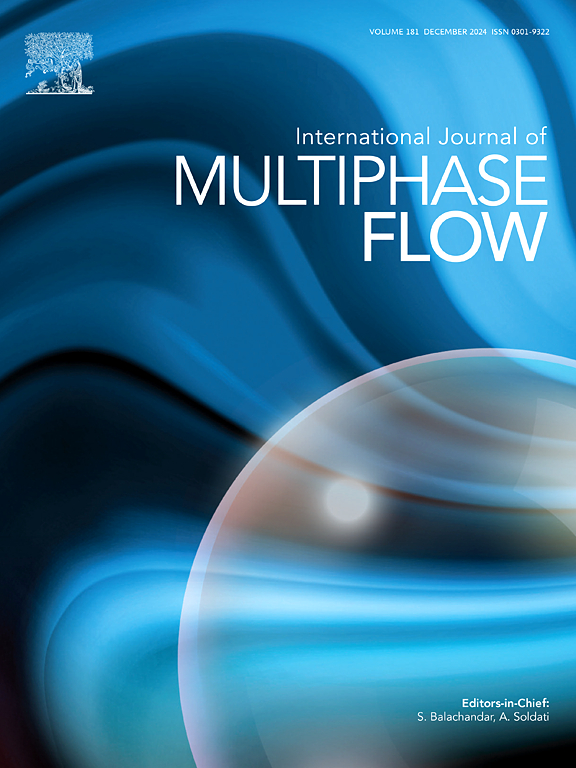Dynamics of electrocoalescence-induced microfluidic droplet merging: Influence of the applied electric field
IF 3.6
2区 工程技术
Q1 MECHANICS
International Journal of Multiphase Flow
Pub Date : 2025-01-13
DOI:10.1016/j.ijmultiphaseflow.2025.105135
引用次数: 0
Abstract
Merging droplets in microchannels is an essential task in a variety of microfluidic systems. In this study, the electrocoalescence of droplets dispersed in an otherwise immiscible fluid within a microfluidic device was investigated numerically. The microfluidic device, comprising a flow-focusing junction, was employed to generate droplets in an otherwise immiscible fluid. Subsequently, the generated droplets were directed over a series of microelectrodes. The continuous and dispersed phases were modeled as incompressible Newtonian fluids. The interface between the phases was tracked using a phase-field model. For a constant electric field, three distinct threshold voltages were identified. No droplet merging was observed at voltages less than the first threshold-voltage. The regular merging of three droplets was noted at voltages beyond the second threshold-voltage and less than the third threshold-voltage. The irregular merging of droplets occurs at voltages beyond the third threshold-voltage. The influence of the interfacial tension on the first threshold-voltage was examined for the constant electric field. The interfacial tension considerably modulates the first threshold-voltage. Investigations were also conducted on the mechanism of droplet coalescence under alternating and pulsed direct-current electric fields, along with the effect of frequency on the first threshold-voltage. The first threshold-voltage increases with increasing frequency in both electric fields. Generally, the effects of frequency are small compared with, for example, the influences of interfacial tension on the first threshold-voltage.
电聚结诱导微流控液滴合并动力学:外加电场的影响
微通道中液滴的融合是各种微流体系统的基本任务。在本研究中,用数值方法研究了微流控装置中分散在不混相流体中的液滴的电聚结。微流控装置,包括一个流动聚焦结,被用来产生液滴,否则不混相流体。随后,生成的液滴被定向到一系列微电极上。连续相和分散相被建模为不可压缩的牛顿流体。采用相场模型跟踪了两相之间的界面。对于恒定电场,确定了三个不同的阈值电压。在低于第一个阈值电压时,没有观察到液滴合并。在高于第二个阈值电压和低于第三个阈值电压时,可以观察到三个液滴的规则合并。液滴的不规则合并发生在超过第三个阈值电压的电压下。在恒定电场条件下,考察了界面张力对第一阈值电压的影响。界面张力在很大程度上调节了第一阈值电压。研究了交变和脉冲直流电场下液滴聚结的机理,以及频率对第一阈值电压的影响。在两个电场中,第一个阈值电压随频率的增加而增加。与界面张力对第一阈值电压的影响相比,频率的影响通常较小。
本文章由计算机程序翻译,如有差异,请以英文原文为准。
求助全文
约1分钟内获得全文
求助全文
来源期刊
CiteScore
7.30
自引率
10.50%
发文量
244
审稿时长
4 months
期刊介绍:
The International Journal of Multiphase Flow publishes analytical, numerical and experimental articles of lasting interest. The scope of the journal includes all aspects of mass, momentum and energy exchange phenomena among different phases such as occur in disperse flows, gas–liquid and liquid–liquid flows, flows in porous media, boiling, granular flows and others.
The journal publishes full papers, brief communications and conference announcements.

 求助内容:
求助内容: 应助结果提醒方式:
应助结果提醒方式:


